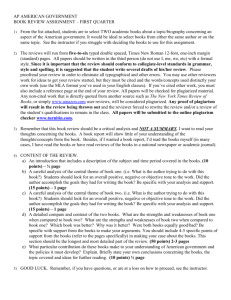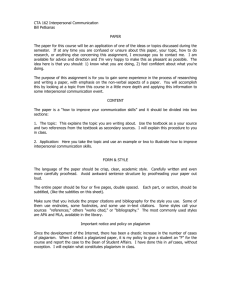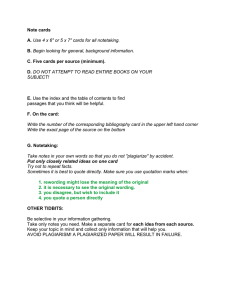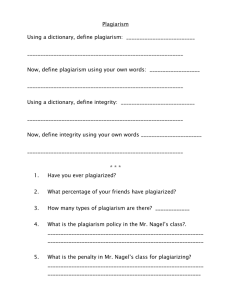What is Plagiarism?
advertisement
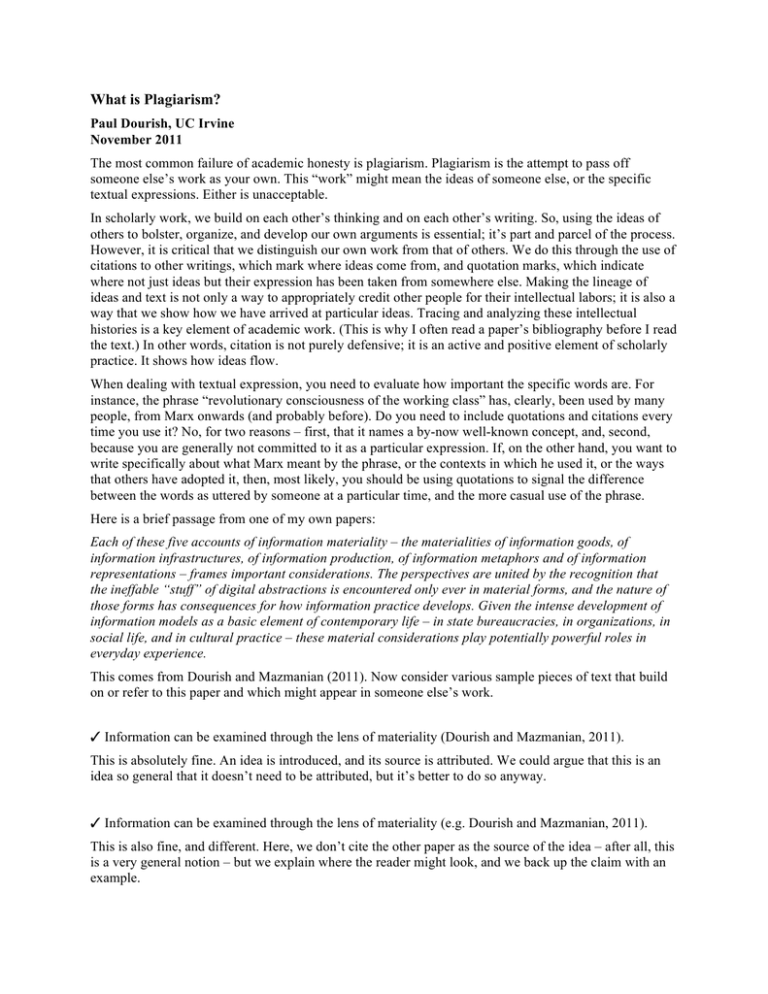
What is Plagiarism? Paul Dourish, UC Irvine November 2011 The most common failure of academic honesty is plagiarism. Plagiarism is the attempt to pass off someone else’s work as your own. This “work” might mean the ideas of someone else, or the specific textual expressions. Either is unacceptable. In scholarly work, we build on each other’s thinking and on each other’s writing. So, using the ideas of others to bolster, organize, and develop our own arguments is essential; it’s part and parcel of the process. However, it is critical that we distinguish our own work from that of others. We do this through the use of citations to other writings, which mark where ideas come from, and quotation marks, which indicate where not just ideas but their expression has been taken from somewhere else. Making the lineage of ideas and text is not only a way to appropriately credit other people for their intellectual labors; it is also a way that we show how we have arrived at particular ideas. Tracing and analyzing these intellectual histories is a key element of academic work. (This is why I often read a paper’s bibliography before I read the text.) In other words, citation is not purely defensive; it is an active and positive element of scholarly practice. It shows how ideas flow. When dealing with textual expression, you need to evaluate how important the specific words are. For instance, the phrase “revolutionary consciousness of the working class” has, clearly, been used by many people, from Marx onwards (and probably before). Do you need to include quotations and citations every time you use it? No, for two reasons – first, that it names a by-now well-known concept, and, second, because you are generally not committed to it as a particular expression. If, on the other hand, you want to write specifically about what Marx meant by the phrase, or the contexts in which he used it, or the ways that others have adopted it, then, most likely, you should be using quotations to signal the difference between the words as uttered by someone at a particular time, and the more casual use of the phrase. Here is a brief passage from one of my own papers: Each of these five accounts of information materiality – the materialities of information goods, of information infrastructures, of information production, of information metaphors and of information representations – frames important considerations. The perspectives are united by the recognition that the ineffable “stuff” of digital abstractions is encountered only ever in material forms, and the nature of those forms has consequences for how information practice develops. Given the intense development of information models as a basic element of contemporary life – in state bureaucracies, in organizations, in social life, and in cultural practice – these material considerations play potentially powerful roles in everyday experience. This comes from Dourish and Mazmanian (2011). Now consider various sample pieces of text that build on or refer to this paper and which might appear in someone else’s work. ✓ Information can be examined through the lens of materiality (Dourish and Mazmanian, 2011). This is absolutely fine. An idea is introduced, and its source is attributed. We could argue that this is an idea so general that it doesn’t need to be attributed, but it’s better to do so anyway. ✓ Information can be examined through the lens of materiality (e.g. Dourish and Mazmanian, 2011). This is also fine, and different. Here, we don’t cite the other paper as the source of the idea – after all, this is a very general notion – but we explain where the reader might look, and we back up the claim with an example. ✗ There are five possible accounts of information materiality: the materialities of information goods, of information infrastructures, of information production, of information metaphors, and of information representations. This is plagiarized. It is lifted almost a word-for-word from the first sentence of the paper. It takes someone else’s text without attribution. ✗ There are several possible accounts of information materiality, including the materialities of information infrastructures, of information production, of information goods, and of information metaphors. This is plagiarized. Although the text has been changed and jumbled, the ideas are still someone else’s, and used without attribution. ✓ Dourish and Mazmanian (2011) propose five possible accounts of information materiality: the materialities of information goods, of information infrastructures, of information production, of information metaphors, and of information representations. This is fine. It gives a citation to explain where the idea came from. What’s more, it sensibly marks the tentativeness of the expression (i.e., it explains that this is someone’s proposal, not a statement of absolute fact.) ✗ The intense development of information models as a basic element of contemporary life in state bureaucracies, organizations, and social life mean that material considerations are potentially powerful elements of experience. This is plagiarized. The ideas are lifted from the source text, as are aspects of the expression. The fact that it has been rewritten does not mean that it’s a new idea. ✗ Information models play an important role in many aspects of everyday life, including in state bureaucracies, in organizations, in social life, and in cultural practice. This is plagiarized. Both the idea and the fundamental textual expression are taken from another unattributed source. ✓ Information models play an important role in many aspects of everyday life, including “in state bureaucracies, in organizations, in social life, and in cultural practice” (Dourish and Mazmanian, 2011). Here, both textual expression and the basic idea are acknowledged as coming from another source. ✓ Information models play an important role in many aspects of everyday life, including in state bureaucracies, in organizations, in social life, and in cultural practice (Dourish and Mazmanian, 2011). Although it is better to mark direct quotations, this is acceptable since the attribution is still made. ✗ Given the intense development of information models as a basic element of contemporary life – in state bureaucracies, in organizations, in social life, and in cultural practice – material considerations play potentially powerful roles in everyday experience (Dourish and Mazmanian, 2011) This is plagiarized. With the modification of only one word, the exact textual expression has been lifted form the paper. Including the citation does not make this clear, and so this is plagiarism even though the source text is cited. ✓ “Given the intense development of information models as a basic element of contemporary life – in state bureaucracies, in organizations, in social life, and in cultural practice – … material considerations play potentially powerful roles in everyday experience” (Dourish and Mazmanian, 2011) This is an appropriate way to incorporate a longer quote. ✓ Dourish and Mazmanian (2011) argue that, “given the intense development of information models as a basic element of contemporary life – in state bureaucracies, in organizations, in social life, and in cultural practice – material considerations play potentially powerful roles in everyday experience.” Also acceptable. ✗ When considering materiality of information systems, our attention is drawn to the ineffable stuff of digital abstractions. This is plagiarized. It includes a significant textual expression (“ineffable stuff of digitial abstractions”) without attribution. ✓ When considering the materiality of information systems, our attention is drawn to what Dourish and Mazmanian call the “ineffable ‘stuff’ of digital abstractions”. This is fine. ✓ Many different accounts of informational materiality are possible (Dourish and Mazmanian, 2011). Fine. And not all citations are quotes. This is a place where, again, we have taken an idea from another person and want to make the lineage clear. ✓ Digital abstractions are encountered only ever in material form (Dourish and Mazmanian, 2011). This is perfectly acceptable. ✗ Digital abstractions are encountered only ever in material form. This is plagiarized. It goes without saying, I hope, that plagiarism is unacceptable in academic work, in the classroom and elsewhere. If you submit plagiarized work in class, you will fail the class and a letter will go into your file. If you submit plagiarized work for external publication, it will be returned without review and will significantly damage your reputation. There is never a good excuse for plagiarism, and if Google and the internet have made it much easier to plagiarize, they have made it much easier to detect plagiarism too. People often claim – both in class and in other contexts – that plagiarism was accidental. This is no defense, and generally will do no good at all, but here are a few pointers to guard against accidental plagiarism: When in doubt, cite. If you are unsure whether or not an idea should be attributed, then the answer is almost definitely that it should be, and there is never a case where a citation is a bad idea. When in doubt, quote. If you are unsure whether or not text should be attributed, then the answer is most likely that it should be, and there is never a case where quote marks are a bad idea. Do not keep unattributed notes. If, as you read a paper, you keep notes on it or extract quotes to help you remember it, or for later consideration, make sure that those are fully attributed (authors, source text, page numbers). That way, if you are writing later from your notes, there is no confusion over what material is yours and what came from source texts. One particularly tricky issue can be that of self-plagiarism, that is, reusing textual material from your own work in subsequent work. Again, citation is the way to resolve this issue. Never reproduce text in order to deceive or to take a short-cut. If you are building on your own previous work, then you should make this clear in the text in order to demonstrate how you are building upon it (extending it, revising it, reevaluating it, repudiating it, etc.) References Dourish, P. and Mazmanian, M. 2011. Media as Material: Information Representations as Material Foundations for Organizational Practice. Third International Symposium on Process Organization Studies (Corfu, Greece).
